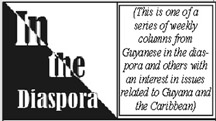By Tennyson Joseph
Towards the end of 2011, the Caribbean witnessed General Elections in three CARICOM member states, Guyana and St. Lucia on November 28th and Jamaica on December 29th. The similarity of these elections, both in terms of outcomes and timing, and their coincidence with the year’s end have provided much food to feed into “end of era” metaphorical appetites.

The first cycle 2006-2008

Thus between December 2006 and July 2008, the governments of St. Lucia, The Bahamas, Jamaica, Barbados, Belize and Grenada all fell to opposition challenges. In that period, only Patrick Manning’s PNM (November 2007) was able to buck the trend, only to be removed by the Peoples’ Partnership in an early election in May 2010. It was not until the Antigua election of March 2009 that the tide of incumbent defeats was reversed, with Roosevelt Skerrit of Dominica, Denzil Douglas of St. Kitts and Nevis, and Ralph Gonsalves of St. Vincent and the Grenadines all managing to retain power.
Many of the governments facing defeat in the 2006-2008 period had introduced fairly successful economic and social programmes. Thus the usual, “it’s the economy, stupid” argument, did not apply in this period. For example Kenny Anthony had satisfactorily managed a transition out of bananas and repositioned St. Lucia into tourism and financial services, Owen Arthur of Barbados had saved the Barbadian economy from the 1990-1994 IMF scenario, and Keith Mitchell of Grenada had managed a smooth recovery from the ravages of Hurricane Ivan. Instead, the central concern of Caribbean voters seemed to have been that many of these governments had been in office for too long, and it was simply time for new leadership. In the case of Barbados, there seemed to be a deep reluctance to facilitate Arthur in breaking the “three term barrier” which, as an accolade, would have placed him above the revered father of the nation, Errol Walton Barrow. The conservative Barbadian instinct would not allow it.
It was clear therefore that, following ten to fifteen years of unchanged governments, Caribbean voters felt fairly secure in placing governance issues above economic considerations. Thus, charges of corruption, arrogance, lack of transparency and accountability and calls for good government were central motifs of the “time for change” theme song. What resulted was a cycle of elections in which concerns about economic growth, jobs and development were down-played, while issues of good governance, image, political style and the need for political turnover were emphasised. It was the Caribbean version of J. K. Galbraith’s “culture of contentment”, writ large.
November 28th: What did the People Say?
The electoral clock was therefore restarted with the troika of elections which ushered in the end of 2011. It is therefore useful to examine what the voters were saying in these elections, and what the future may hold for the other Caribbean governments.
The similarity shared by St. Lucia and Guyana was the closeness of the elections. In the case of St. Lucia, whilst in the last election the two parties were separated by roughly 2000 votes, in 2011 a difference of 3000 votes separated the victorious from the vanquished. In addition, whilst Kenny Anthony’s Opposition St. Lucia Labour Party (SLP) emerged victorious, with an 11-6 majority, in many of the constituencies the SLP won by very narrow leads, with margins of two and seven votes being the most dramatic cases. Indeed three of the seats are currently being legally challenged by the UWP.
In Guyana’s dramatic November 28th 2011 election, the previously dominant ruling PPP/Civic, lost its majority in parliament whilst holding on to the Presidency. The PPP/Civic, holding 32 seats to the 33 held jointly between A Partnership for National Unity APNU (26) and the Alliance For Change AFC (7), is now challenged with the complexity of governing a divided, multi-racial state without the cushion of a parliamentary majority.
The most important lesson therefore, must be the continued splitting of these countries straight down the middle. In the case of Guyana, the racial marker continues to be the main divider, whilst in St. Lucia it is party affiliation. Significantly in St. Lucia, the UWP founded by the country’s “father of independence” John Compton, was able to perform strongly, despite its governance challenges, which included open splits against Compton’s successor Stephenson King, allegations of corruption against government parliamentarians, the revocation by the US of the visa of one sitting minister, and the revelations of criminal incarceration in the US of the Minister of Foreign Affairs, Rufus Bousquet.
In Guyana too, the ruling PPP/Civic entered the election against a backdrop of damning corruption allegations and the pervasive sense that the regime had been transformed into its opposite – the administration of Forbes Burnham or worse (indeed, the jostling over the electoral count by the ruling party provided a chilling suggestion that the spirit of the Burnham years had fully possessed the party which once opposed him).
Whilst these election results, including those of Jamaica, suggest a growing sensitivity of Caribbean voters to the obscenity of corruption and a rejection of odious government, the strong showing by the established parties suggest that Caribbean voters remain loyal to their traditional parties and may tend to “hold their noses”, close their eyes and numb their consciences and vote party. What this means for the many Caribbean countries which have themselves experienced close elections in recent times, is that despite the global crisis, and despite the limited successes of many a ruling administration, the coming round of elections will be close political battles. The era of the mass landslides may be a while in returning. Antigua, St. Vincent, and now St. Lucia and Guyana, have shown that our elections can move in any direction, determined only by the superior mobilisation of the various parties on election day.
For opposition parties this should present exciting possibilities, while for ruling administrations it should evoke grave concern. Gone are all guarantees of fixed terms, fixed bases, and fixed tactical methods of winning elections. Indeed Guyana showed that even the assumed racial voting may not provide any comfort to parties depending on Malthusian racial majorities. Both St. Lucia and Guyana showed that despite the superior spending capacity of the governing parties, their record of governance failures proved too overwhelming to blind voters to the lure of short term money, provided either by interfering foreign governments or the local business class, legitimate or illegitimate. In the coming elections the current ruling regimes will have to think hard about the glitzy, concert-filled, party-like presidential campaigns, sans issues, that have marked recent elections.
Further, the closeness of elections may mean that individual candidates may have to dig deeper in establishing democratic links with their constituents. In a context of reduced delivery capacity by the state, candidates will have to step up to fill the breach, placing tremendous pressure on incumbents.
The most enduring lesson of St. Lucia and Guyana therefore, is the deep political divisions which continue to persist. In both countries, the first order of business of the new governments will be to unite their respective peoples. Whilst in St. Lucia the absence of racial division, a smaller population size, and a historically less troubled past may assist Kenny Anthony in a healing project, the story from Guyana’s electoral result and its aftermath suggests a rockier road. Perhaps, History, in its own clever logic, has thrown the baton of responsibility for healing, not at the feet of the government, but has placed it in the hands of the people and the multi-headed party creature through which their aspirations are canalised.
December 29th: Jamaica and the Caribbean’s Future
If any doubts existed over whether the Caribbean voters were intent on reversing the decisions which they undertook in the 2006-2008 electoral cycle, then the Jamaica election of December 29th provided a clear answer of the voters’ intention to “change the change”. Thus, despite pollster predictions of a close election with a likely Jamaica Labour Party (JLP) victory, the final outcome was a 42-21 victory for Portia Simpson-Miller’s Peoples’ National Party (PNP).
There is no doubt that a central factor playing on the mind of the Jamaican voter was the descent into near anarchy associated with former Prime Minister Bruce Golding’s handling of the ‘Dudus’ Coke Affair. Just as in St. Lucia and Guyana therefore, the electorate was being called upon to adjudicate on issues of bad governance and corruption. Once again, it was clear that yet another Caribbean administration had failed to live up to the promise of good government upon which its election had been predicated in the previous cycle. In this regard therefore, the youthful Andrew Holness proved a sorry scapegoat for Bruce Golding.
Also significant from the Jamaica election was the fact that, following so closely upon the heels of the rejection of the Stephenson King administration in St. Lucia after only one term in office, it raised obvious concern for many of the other regional governments which had emerged to office on the tide of change in the last electoral cycle.
Interestingly, one such country which has felt the ripples of both the Saint Lucia and Jamaica election has been Barbados. Immediately following the St. Lucia election, newspaper reports were dominated by suggestions of moves to replace the existing Prime Minister, Freundel Stuart, with a more youthful and charismatic leader, given the similarities between Stuart’s method of elevation to office, personality and leadership style with that of King.
Whilst the political tensions in Barbados persist, the failure of the Jamaica experiment has provided much cause for pause on the part of the groups seeking leadership change. Despite this however, there is a pervasive sense in Barbados and elsewhere that the pattern of one-term governments is set to continue.




